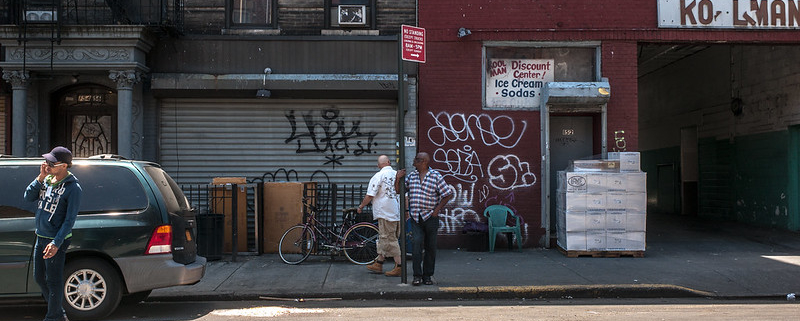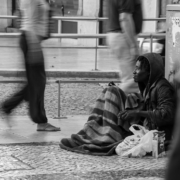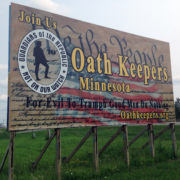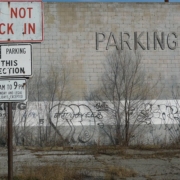Sound Check? Music, Noise, and Street Culture
It’s Spring again. After a long hard year with COVID-19 bearing down on us, the roll out and adoption of vaccines to address this global health crisis, and the shadow of the wreckage left behind by former President Trump, an increasing number of city dwellers are emerging from their residences and on to the streets of our big cities.
Meanwhile, the whir of traffic is picking up, as more people are returning to their jobs, businesses once shuttered are opening or increasing their activity, and more individuals are working and playing outdoors. Very soon, all types of sounds and noise in urban public spaces and resident’s desire and need for peace and quiet will come into conflict.
Not all sounds in urban environments are noise and not all noise is equal in their effect on the surrounding neighborhood. Issues of volume, duration, and disturbance are considerations in the relationship between people and organizations who create noise and those who respond to it. More immediate, however, is whether noise and sound is relatively fixed or transitory and our reactions to this disturbance.
On the one end of the spectrum there are situations where the noise is fixed. If, for example, you move to or live in a residence or area, near or beside the L, train tracks, or an airport then you should expect to hear noise. Subways, trains and airplanes, more specifically the paths they take are pretty much fixed. Yes, the entities that build and run these means of transportation can install noise dampening mechanisms, but sooner or later you are going to hear the noise that these mobility solutions produce. Similar arguments are present if you move to or live close to a music venue, record store, or garage.
On the other end of the spectrum, is what might be described as temporary or transitory sound. Here the noise comes and goes dependent on the time of day, season, and activity. This includes the amateur musician who busks on the street corner, the group of friends who meet in the park for a picnic and bring their boom box along, the work crew using jackhammers to break through the pavement, the landscapers who use leaf blowers at the end of the job, and the young man who drives his muscle car through the neighborhood, widows open, with his car stereo with subwoofers blaring music.
In the case of fixed noise, there is little that residents can do to improve the situation (i.e., minimize the noise). Yes they can convince local authorities to change flight paths, have the subways run less often at night, if they don’t do that already, etc. But in general what you see is what you get. With respect to the transitory noise, the saving grace is that very soon the individual/s who produce the sounds, will move to a different location, and hopefully you can go about your business with a minimum of disturbance.
That being said, there are anomalies in the fixed and transitory spectrum and they are difficult to specify an appropriate reaction to. For years now, in parts of Williamsburg (Brooklyn), groups mostly composed of young men of Dominican Republic and Puerto Rican origin, bring large speakers to the sidewalk and play music loudly. Beyond the neighborhood barber shops, crowded bodegas, and street fairs, these sidewalk scenes are important activities because they allow these individuals an opportunity to interact with similar people, share stories, and stave off the alienation of city life, dead end jobs, a society that often seems much too cruel, and build community.
Similarly in Washington, DC, dating back a handful of years, on the corner of 7th and Florida Ave. NW, in the Shaw district, Central Communications, a cell phone store has set up powerful speakers outside, that blasts Go-go music, starting early in the morning and lasting until late at night. The music can be heard for blocks away.
It was not until 2019, that some residents, mostly those who recently moved to the gentrifying neighborhood, complained to the parent company and local politicians, and this information made its way to the local news media. Soon thereafter activists, and others holding on to romantic notions of what Shaw used to be like, complained how the gentrifiers were destroying their neighborhood, how they were racist, and insensitive to local history, culture, and social class, because they were complaining not only about a black owned business, but an African-American cultural art form (Go-go) that had its origins in the streets of DC. Muriel Bowser, the mayor, and a handful of DC politicians sided with the activists. There is no question that gentrification is displacing local culture, and there are people who are hurt by these developments.
Both the Williamsburg and Shaw examples are cases where the noise is both fixed and transitory and they require more complex understandings of these kinds of situations and responses to them.
On the one hand, people considering moving to these neighborhoods should not be surprised, by the proximate noise. Thus, we can say too bad, you should have done your due diligence, and if you don’t like it, maybe you should find a different neighborhood to live in?
On the other hand, we also know that neighborhoods change, people get older, and just because newcomers may have difficulties with the noise, trash, street crime, graffiti, or all manner of urban incivilities, does not mean the residents who lived there before the influx of the gentrifiers, didn’t also have problems with the noise, etc., Their complaints may not have been taken seriously, or they may have felt powerless to complain. Therefore their relative silence cannot be interpreted as acceptance of the noise or music. We just don’t know.
It is in these situations, that we find the essence of street culture butting heads with norms, values, and orientations. They are also times when arguments, some evidenced-based and others spurious get made. Likewise some of statements and interpretations are quickly believed, while others are summarily dismissed. Regardless of those arguments that have the most salience, we must recognize that culture and space and the things like noise and music change. We need to be constantly on guard for simplistic arguments when this happens.
Photo Credit: Susan Sermoneta
Williamsburg, Brooklyn











